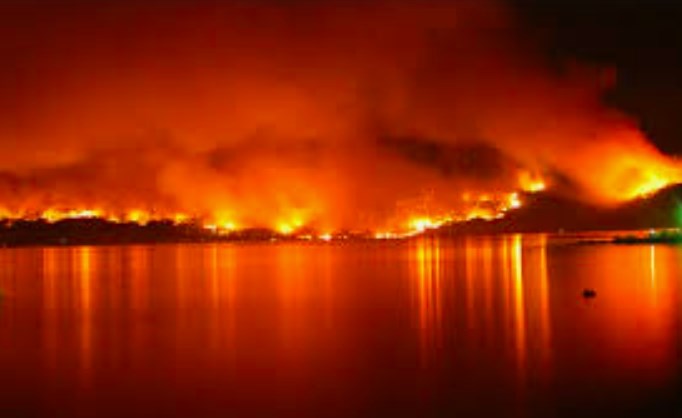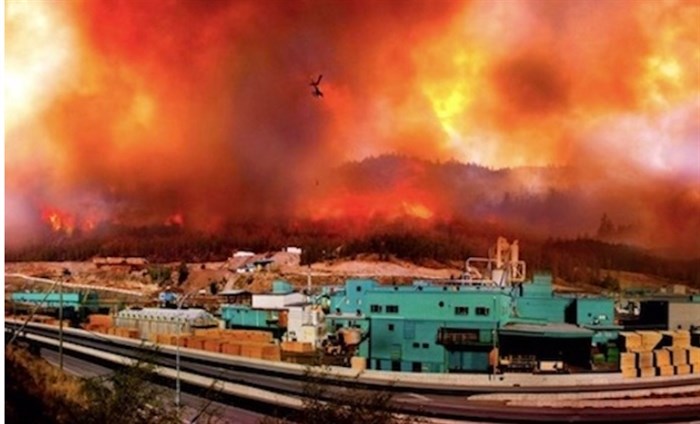
Image Credit: Submitted/Ministry of Forests
July 08, 2023 - 12:00 PM
It was described as the “most significant interface wildfire event in BC history,” by the provincial government.
It triggered the second largest civilian evacuation in Canadian History and was described as a “one-in-a-hundred-year inferno” by the City of Kelowna.
The Okanagan Mountain Park Wildfire was sparked by lighting on Aug. 16, 2003 and within days it had destroyed 238 houses and a winery. It triggered the evacuation of 33,050 people, nearly half the city at the time.
Over the course of the following month, the fire burned 26,600 ha and destroyed 12 trestles along the Kettle Valley rail line above the city.
Pretty dramatic statistics at the time.
But ask the people of Lytton, Fort McMurray or Slave Lake and it's barely in the conversation.
According to the Guinness World Records website, the are two contenders for the largest wildfire in the world.
“The Chinchaga Fire started in logging slash in BC on 1 June 1950 that grew out of control and ended five months later on 31 October in Alberta; in that time, it burned approximately 1.2 million hectares of boreal forest,” it says.
The other contender was the 1987 Great Black Dragon Fire in north-east China and across the border into the Siberian Russia between May 6 and June 2, 1987. It was about the same size but killed more than 200 people.
At 26,600 ha, the Okanagan Mountain Park Wildfire was pretty small by comparison.
A hectare is about the size of the grassy area inside a 400-metre running track, such as Kelowna’s Apple Bowl.
READ MORE: How a deadly slide in Kelowna saved homes in a wildfire a decade later
The largest peacetime evacuation in Canadian History was in 1979 in Mississauga where 45,000 people were evacuated after a train wreck where 24 cars went off the track. Some of those were carrying propane and butane and ruptured. No one was seriously injured or killed.
At that time, it was the largest evacuation in North American history, according to the Canadian Red Cross.
Okanagan Mountain Park came in second in 2003 with its 30,050 evacuees.
Both rankings were eclipsed by the Fort McMurray Wildfire that burned in Alberta from April 30 to June 1, 2016. It forced the evacuation of more than 90,000 people.
It burned 579,676 ha, destroyed 2,400 homes and businesses and was referred to as the most expensive natural disaster in Canada’s history by Public Safety Canada.
Before that fire, Lesser Slave Lake eclipsed the Okanagan in terms of buildings lost.
That fire started on May 14, 2011 and was relatively small at 4,700 ha but 433 buildings burned and 7,000 people were evacuated.
On June 30, 2021, a wildfire tore through Lytton, burning down most of the village and killing two people.
While the fire burned 83,000 ha into August, the property damage was all done in one night, destroying 151 homes and businesses.
READ MORE: Dozens of Kelowna homes were almost bulldozed during wildfire 20 years ago
Also, in 2021, the White Rock Lake Wildfire burned 83,671 ha stretching from the west side of Okanagan Lake past Monte Lake.
It was first spotted on July 13 and burned through August, destroying 78 homes in the Central and North Okanagan.
READ MORE: iN PHOTOS: The devastation left behind by the White Rock Lake wildfire near Vernon
Looking back, 2003 was seen as one of the worst wildfire seasons in BC’s history when almost 2,500 fires burned more than 265,000 ha.
Annual reports from BC Wildfire Service posted online go back to 2009.
In that year, there was a 400 ha fire in Glenrosa with three structures burned, another 200 ha fire near Rose Valley Dam and a 9,277 ha fire in the Terrace Mountain area west of Fintry.
READ MORE: Ten years ago this week, West Kelowna was surrounded by wildfire

Gorman Brothers Lumber Mill threatened by flames during the 2009 Glenrosa Wildfire.
Image Credit: Submitted/Stephanie Whiting
Things were relatively quiet until 2014 when almost 360,000 ha were burned, the third highest in BC’s history at the time.
Those fires included 280 acres near Smith Creek in West Kelowna, 101 ha at Boot Hill southwest of Penticton and 345 ha on Apex Mountain.
In 2015, there was a 55 ha fire near Joe Rich along Highway 33 and 560 acres above Westside Road in the Okanagan.
In 2017, a record 1.2 million hectares were burned and about 65,000 people evacuated in BC. A state of emergency was declared on July 7 and ran for 70 days, the longest state of emergency since 2003.
Fires included the 191,865 ha Elephant Hill Wildfire that burned from Ashcroft to Highway 24, a 465 ha fire near Joe Rich east of Kelowna and a 2,224 ha fire southwest of Peachland.
The Plateau Complex fire in the Chilcotin region burned 545,151 ha, making it the largest fire in BC recorded history, at the time. The Chinchaga Fire, while larger, burned mostly in Alberta.
That Chilcotin Plateau record was broken in June by The Donnie Creek Wildfire burning north of Fort St. John.
That 2017 provincial record for hectares burned was broken in 2018 when more than 1.35 million ha burned. That included the Okanagan Complex where four fires burned more than 3,900 ha.
Many of the province’s biggest fires over the years have been in the north but, with Lytton, White Rock Lake and other fires in 2021, the reality of wildfires came closer to the Thompson-Okanagan.
That year triggered a provincial state of emergency for 56 days, from July 21 to Sept. 14, and burned 869,279 ha.
A wet spring last year resulted in a quieter fire season with a mere 133,437 ha burned.
This year, however, is shaping up to be another devastating wildfire year, not only for BC but for all of Canada where major fires started burning early in the year in Alberta, New Brunswick, Quebec and northeastern BC.
To contact a reporter for this story, email Rob Munro or call 250-808-0143 or email the editor. You can also submit photos, videos or news tips to the newsroom and be entered to win a monthly prize draw.
We welcome your comments and opinions on our stories but play nice. We won't censor or delete comments unless they contain off-topic statements or links, unnecessary vulgarity, false facts, spam or obviously fake profiles. If you have any concerns about what you see in comments, email the editor in the link above.
News from © iNFOnews, 2023